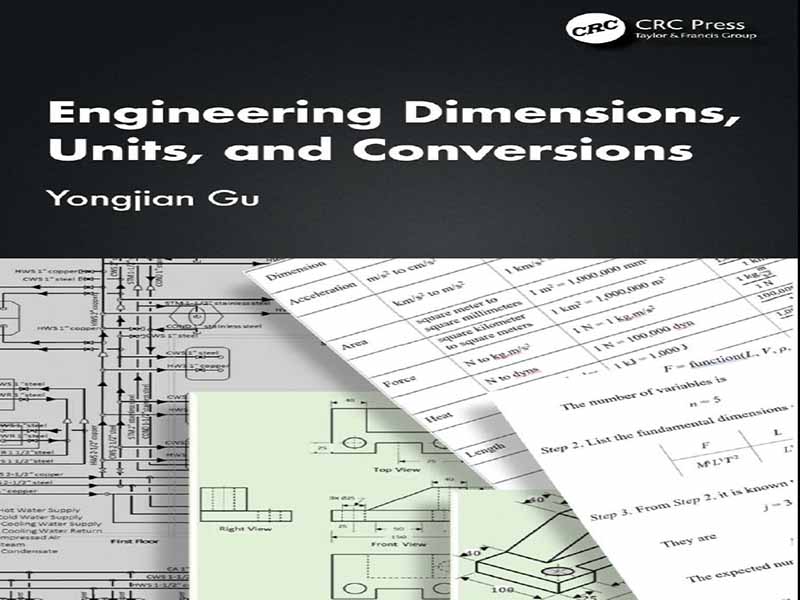- عنوان کتاب: Engineering Dimensions, Units, and Conversions
- نویسنده: Yongjian Gu
- حوزه: ابعاد مهندسی
- سال انتشار: 2025
- تعداد صفحه: 273
- زبان اصلی: انگلیسی
- نوع فایل: pdf
- حجم فایل: 5.29 مگابایت
این کتاب به توصیف، تجزیه و تحلیل و کاربرد ابعاد مهندسی، واحدها و تبدیل واحدها می پردازد. ابعاد نشان دهنده انواع اندازه گیری کمیت های فیزیکی است، در حالی که واحدها نشان دهنده بزرگی های اختصاص داده شده به اندازه گیری های مرتبط این کمیت ها هستند. هر دو ابعاد و واحدها نقشی محوری در عمل مهندسی دارند. عدم به کارگیری صحیح آنها منجر به سردرگمی در محاسبات و نقشه های طراحی مهندسی و تحقیق و طراحی (R&D) می شود. ابعاد و واحدها به ابعاد و واحدهای بنیادی که به آنها اولیه نیز گفته می شود و ابعاد و واحدهای مشتق شده که به آنها ثانویه نیز گفته می شود، دسته بندی می شوند. ابعاد و واحدهای بنیادی مبانی هستند، در حالی که ابعاد و واحدهای مشتق شده از بنیادی به دست میآیند و میتوان آنها را در قالبهای بنیادی بیان کرد. بیان واحد مناسب در محاسبات و نقشه ها از قالب ها و قوانین مرسوم مانند روش های ابعاد، ارقام مهم و گرد کردن اعداد پیروی می کند. در عمل مهندسی، سازگاری ابعاد و واحدهای کمیت در عبارات فیزیکی و محاسبات معادلات بسیار مهم است. ابعاد و واحدهای ناسازگار نباید در معادلات مانند جمع، تفریق، ضرب و تقسیم دستکاری شوند. در ایالات متحده، دو سیستم واحد در عمل مهندسی استفاده می شود. یکی سیستم انگلیسی که سیستم عرفی ایالات متحده (USCS) نیز نامیده می شود، و دیگری سیستم بین المللی (SI) است که به آن سیستم متریک نیز می گویند. تبدیل واحدها در سیستم و بین سیستم ها برای حفظ ثبات واحد ضروری است. تحلیل ابعادی برای کمک به بررسی سازگاری واحد در عبارات فیزیکی و محاسبات معادلات و تعیین رابطه ابعاد بین کمیت های فیزیکی مفید است. اعداد بدون بعد حاصل از تجزیه و تحلیل ابعادی برای آشکار کردن ویژگی ها و رفتارهای پدیده های پیچیده در تحقیق و توسعه بسیار ارزشمند هستند. این کتاب از هشت فصل تشکیل شده است که شرحهای قبلی را پوشش میدهد: فصل 1 با تأکید بر کاربرد لازم ابعاد و واحدها در مهندسی و تبیین نقش ضروری آنها در عمل مهندسی، زمینه را فراهم میکند. برای دانشجویان رشته مهندسی، مهندسین درگیر در رشته مهندسی، و کسانی که برای امتحانات FE/PE آماده می شوند بسیار مهم است که واحدهای ابعاد و تبدیل واحدها را به طور کامل درک و به درستی اعمال کنند. فصل 2 به پیچیدگی های ابعاد در مهندسی می پردازد، ابعاد بنیادی و مشتق شده را به طور جامع توصیف می کند و اصل همگنی ابعادی را به عنوان یک عامل کلیدی در حفظ ثبات ابعادی نشان می دهد. اصل همگنی ابعادی یک اصل اساسی در تحلیل ابعادی است. فصل 3 به چشم انداز گسترده واحدها در مهندسی می پردازد، کاوش کاملی از هر دو واحد اساسی و مشتق شده ارائه می دهد و سیستم های واحد مختلف را در سیستم انگلیسی و SI با جزئیات به تصویر می کشد. در این فصل، دستورالعملهای بکارگیری واحدها در SI شامل قوانین رایج، جداکنندههای اعشاری و پیشوندهای واحد ارائه شدهاست. فصل 4 به فرآیند پیچیده تبدیل واحد اختصاص داده شده است، بینش هایی را در مورد ضریب تبدیل واحد و نسبت تبدیل واحد ارائه می دهد و به طور کامل تبدیل واحدها را در سیستم انگلیسی، SI، و بین دو سیستم نشان می دهد. در فصل تبدیل واحد با استفاده از نرم افزار کامپیوتری نیز معرفی شده است. فصل 5 دنیای تجزیه و تحلیل ابعادی را آشکار می کند، روش های معادلات غیربعدی و قضیه پی را برای به دست آوردن اعداد بی بعد توصیف می کند، و به طور مفصل روش های تولید اعداد بدون بعد را ارائه می دهد، که به درک پدیده های فیزیکی پیچیده کمک می کند. در این فصل، اعداد بدون بعد رایج مورد استفاده ارائه شده است. فصل 6 نگاه دقیق تری به نقش واحدها و تبدیل واحدها در محاسبات معادله می اندازد و بر اهمیت سازگاری واحد تأکید می کند. این فصل همچنین به قوانین مرسوم برای چگونگی فرموله کردن مقادیر عددی در محاسبات معادلات، مانند ارقام مهم و گرد کردن اعداد می پردازد. فصل 7 بحث گسترده ای در مورد مبانی ابعاد اجسام در نقشه های مهندسی ارائه می دهد. تصاویر متعددی از ابعاد اجسام بر روی نقشه ها ارائه شده است. فصل 8 دانش پایه و عملی لوله ها، کانال ها و ابعاد لوله ها و مجاری سیستم های لوله و کانال را ارائه می دهد. نقشه های معمولی از ابعاد سیستم های لوله و کانال ارائه شده است. این کتاب که با مثالهای متعدد، تمرینهایی از جمله برخی از سبکهای موجود در سبک امتحان FE و نقشهها غنی شده است، به عنوان منبعی جامع برای دانشجویان رشتههای مهندسی، مهندسین درگیر در رشته مهندسی، و کسانی که برای آزمونهای FE/PE آماده میشوند تا ابعاد، واحدها و تبدیل واحدها را بهطور کامل درک و بهدرستی اعمال کنند. این کتاب همچنین می تواند به عنوان یک کتاب درسی در دانشکده های مهندسی و مرجعی برای مهندسین استفاده شود…
This book delves into the description, analysis, and application of the engineering dimensions, units, and unit conversions. Dimensions represent measurement types of physical quantities, while units denote the magnitudes assigned to the correlated measurements of these quantities. Both dimensions and units play a pivotal role in engineering practice. Failing to correctly apply them leads to confusion in calculations and drawings for engineering design and research and design (R&D). Dimensions and units are categorized into the fundamental, also known as the primary, dimensions and units and the derived, also known as the secondary, dimensions and units. The fundamental dimensions and units are basics, while the derived dimensions and units are derived from the fundamental and can be expressed in terms of the fundamental ones. Proper unit expression in calculations and drawings follows conventional formats and rules, such as dimensioning methods, significant figures, and rounding off numbers. In engineering practice, the consistency of dimensions and units of quantities is crucial in physical expressions and equation calculations. Inconsistent dimensions and units should not be manipulated in equations, such as addition, subtraction, multiplication, and division. In the United States, two unit systems are used in engineering practice. One is the English system also called the United States Customary System (USCS), and another is the International System (SI) also called the metric system. Unit conversions in the system and between the systems are essential to maintain unit consistency. Dimensional analysis is useful to help check the unit consistency in physical expressions and equation calculations and determine the relationship of dimensions between physical quantities. The dimensionless numbers resulting from dimensional analysis are extremely valuable to reveal the characteristics and behaviors of the complex phenomena in R&D. This book is composed of eight chapters to cover the previously mentioned delineations: Chapter 1 lays the groundwork by emphasizing the necessary application of dimensions and units in engineering and elucidating their indispensable role in engineering practice. It is so important for students majoring in engineering, engineers engaging in engineering practice, and those preparing for the FE/PE exams to thoroughly understand and correctly apply the dimensions units, and unit conversions. Chapter 2 delves into the intricacies of dimensions in engineering, comprehensively describes the fundamental and derived dimensions, and illustrates the principle of dimensional homogeneity as a key factor in maintaining dimensional consistency. The principle of dimensional homogeneity is a basic axiom in dimensional analysis. Chapter 3 ventures into the expansive landscape of units in engineering, offers a complete exploration of both fundamental and derived units, and portrays in detail various unit systems in both the English system and the SI. In the chapter, the guidelines of applying units in the SI, including common rules, decimal separators, and unit prefixes, are presented. Chapter 4 is dedicated to the intricate process of the unit conversions, providing insights into the unit conversion factor and the unity conversion ratio and fully illustrating the unit conversions in the English system, the SI, and between the two systems. In the chapter, the unit conversion using computer software is also introduced. Chapter 5 unveils the world of dimensional analysis, describes the methods of nondimensionalized equations and Pi theorem to obtain dimensionless numbers, and detailly presents the procedures to generate the dimensionless numbers, which help with understanding complex physical phenomena. In the chapter, commonly used dimensionless numbers are presented. Chapter 6 takes a closer look at the role of units and unit conversions in equation calculations and underscores the importance of unit consistency. The chapter also delves into conventional rules for how to formulate numerical values in equation calculations, such as significant figures and rounding off numbers. Chapter 7 provides an extensive discussion of basics of dimensioning objects in engineering drawings. Numerous illustrations of dimensioning objects on drawings are presented. Chapter 8 offers basic and practical knowledge of pipes, ducts, and dimensioning pipes and ducts of pipe and duct systems. Typical drawings of dimensioning the pipe and duct systems are presented. The book, enriched with numerous examples, exercises including some in the style found on the FE exam style, and drawings, serves as a comprehensive resource for students majoring in engineering, engineers engaging in engineering practice, and those preparing for the FE/PE exams to thoroughly understand and correctly apply the dimensions, units, and unit conversions. The book can also be used as a textbook in engineering colleges and a reference for engineers and researchers in engineering design and R&D.
این کتاب را میتوانید از لینک زیر بصورت رایگان دانلود کنید:




































نظرات کاربران